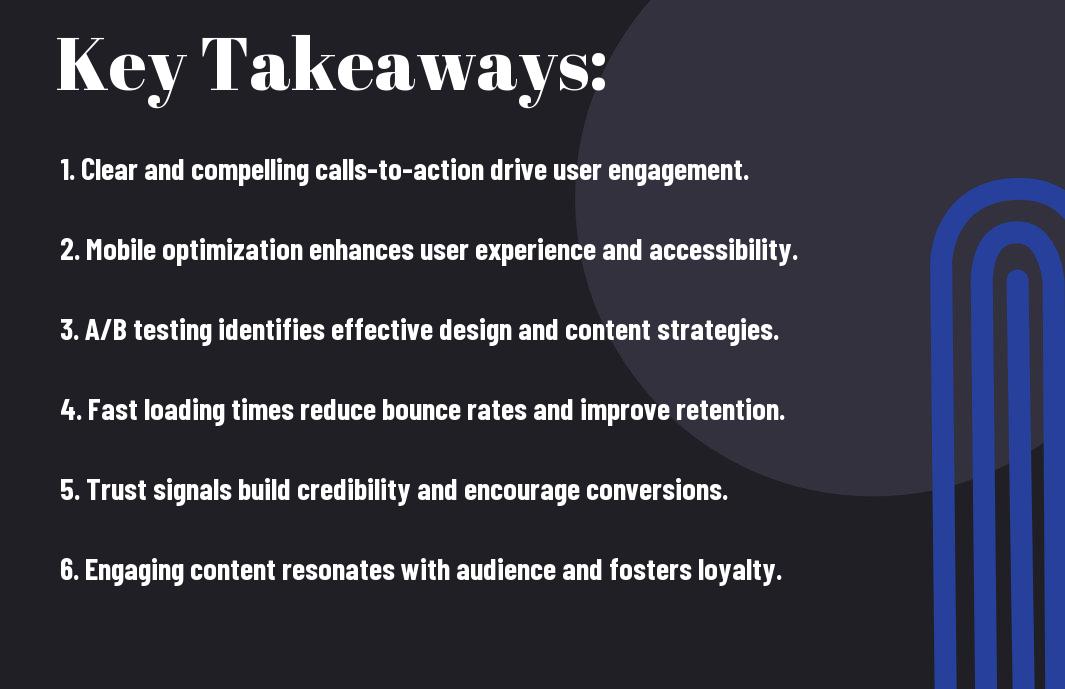Over time, many small enterprises struggle to convert visitors into loyal customers. To turn your website into a conversion powerhouse, you need to understand the key elements that drive engagement and persuade visitors to take action. These secret ingredients include effective calls-to-action, an intuitive user experience, and compelling content that resonates with your audience. By optimizing these components, you can significantly enhance your website’s performance and boost sales, ensuring your business thrives in a competitive market.
Key Takeaways:
- Optimize website design and layout to create a user-friendly experience that encourages visitors to engage and take action.
- Utilize high-quality content and engaging visuals to communicate your value proposition clearly, fostering trust and interest from potential customers.
- Implement data-driven strategies, such as A/B testing and analytics, to continuously refine and enhance conversion pathways based on user behavior and feedback.

Understanding Website Conversion Optimization
Your website conversion optimization is the process of enhancing your online platform to turn visitors into customers or leads. This practice is especially vital for small enterprises as it directly influences profitability and growth by maximizing your existing traffic. With effective conversion strategies, you can create a more engaging user experience that motivates visitors to take the desired action, whether that be making a purchase, signing up for a newsletter, or contacting your business.
Definition and Importance
With a solid understanding of conversion optimization, you can identify and implement techniques that increase your site’s efficiency in generating revenue or leads. The importance of this process is evident as it allows small enterprises to compete effectively in a crowded market by ensuring that every visitor has the potential to become a paying customer.
Key Performance Indicators (KPIs)
Importance lies in the tracking and analysis of Key Performance Indicators (KPIs), which provide insights into how well your website is performing in terms of conversions. Monitoring these metrics allows you to identify areas for improvement and adjust your strategies for optimal results.
In fact, focusing on KPIs like conversion rate, bounce rate, and average session duration will give you a comprehensive view of your website’s effectiveness. By paying attention to these indicators, you can pinpoint which aspects of your site are succeeding and which need adjustment. For instance, if your conversion rate is low, it may suggest that your calls to action are ineffective or that your site’s design does not facilitate easy navigation. Tracking KPIs equips you with the data needed to make informed changes that can significantly boost your conversion rates.
Identifying Target Audience
One of the fundamental steps in website conversion optimization is identifying your target audience. Understanding the specific demographics, interests, and pain points of your ideal customers allows you to tailor your messaging and offerings to resonate deeply. By doing this, you position your small enterprise to effectively meet their needs and convert visitors into loyal customers.
Creating Buyer Personas
Audience segmentation becomes easier when you create detailed buyer personas. These semi-fictional characters represent your ideal customers based on research and data. By defining attributes such as age, profession, and purchasing behavior, you gain insight into their motivations and preferences, enabling you to craft targeted marketing strategies that attract and engage them effectively.
Anayzing User Behavior
Above all, analyzing user behavior on your website provides invaluable insights into how visitors interact with your content. By using tools like heatmaps and analytics, you can identify which pages capture attention and where potential customers lose interest. Understanding these patterns enhances your ability to optimize your site for higher engagement and conversions.
Another aspect of analyzing user behavior is recognizing high-performing content and areas for improvement. By monitoring user flow through your pages, you’ll spot critical drop-off points and discover which elements are driving conversions. This data empowers you to make informed decisions about your design and content strategy, ensuring your website aligns with user preferences for a more effective optimization process.
Crafting Compelling Content
Unlike generic content that fails to resonate, crafting compelling content is vital for engaging your audience and transforming visitors into loyal customers. You must understand your target audience’s preferences and pain points, allowing you to create messages that speak directly to their needs. By incorporating storytelling, emotional triggers, and relatable language, you can effectively capture attention and motivate your readers to take action.
Value Proposition
With a strong value proposition, you clearly articulate why your product or service is the best choice for your customers. This persuasive statement should highlight the unique benefits and features that set you apart from the competition. When done right, your value proposition can significantly enhance the likelihood of conversions by addressing your audience’s specific desires and concerns.
Effective Call-to-Actions (CTAs)
Above all, effective call-to-actions (CTAs) are vital for guiding your audience towards the desired actions. These prompts should be persuasive and easy to understand, creating a sense of urgency while providing clear instructions on what to do next. Your CTAs must stand out visually and strategically appear within your content to catch your audience’s attention at the right moment.
This approach ensures that your CTAs are not just an afterthought but a central aspect of your conversion strategy. Apply actionable language that evokes a sense of urgency and clearly states the benefits of acting now. It’s important to test different designs and placements of your CTAs to find the most effective combination that resonates with your audience, ultimately leading to higher conversion rates and ensuring you are not missing out on potential opportunities.
Design and User Experience
After focusing on quality content, your website’s design and user experience play an imperative role in converting visitors into customers. An engaging, aesthetically pleasing layout coupled with intuitive features can significantly enhance user satisfaction and drive action. Invest time into understanding your target audience and ensure your website reflects their expectations and needs, effectively leading them through the desired journey.
Responsive Design
Experience a seamless browsing experience with responsive design, which ensures your website looks great and functions well on all devices. A responsive site adapts to various screen sizes, enhancing accessibility and engagement across smartphones, tablets, and desktops, ultimately helping you reach a broader audience.
Navigation and Usability
Navigation is a key element of usability, guiding your visitors effortlessly towards their goals. A well-structured menu, clear labels, and logical flow empower users to find information without frustration. By prioritizing navigation, you improve user experience and keep visitors engaged, increasing your likelihood of conversion.
A solid navigation structure acts as a roadmap for your visitors, directing them through your content and towards desired actions. If users struggle to find what they’re looking for, they may leave your site in search of more user-friendly alternatives. Optimize your menus and consider dropdowns or search bars to enhance usability. Small adjustments, such as clear call-to-action buttons, can also significantly impact how easily customers can navigate your site and make choices that benefit your business.
A/B Testing and Data Analysis
Many small enterprises often overlook A/B testing as a powerful tool for optimizing website conversion. By systematically comparing two versions of a web page or element, you can identify which design or content resonates better with your audience. Utilizing data analysis allows you to make informed decisions that enhance user experience and boost conversions, keeping your business competitive in the online space.
Importance of Testing
To improve your website’s performance, A/B testing is crucial for gathering data on user behavior and preferences. This enables you to make data-driven changes rather than relying on assumptions. By testing various elements like headlines, images, or calls-to-action, you ensure that your updates are both effective and aligned with your audience’s desires.
Interpreting Results
Before exploring into data, focus on defining clear goals for your tests to better understand the impact of changes. Analyze metrics such as conversion rates, user engagement, and bounce rates to gauge performance effectively.
Testing allows you to uncover valuable insights about how different elements perform on your site. Analyzing the data means looking at what works and what doesn’t, leading you to improve your conversions based on clear evidence. It’s important not to rush your conclusions; instead, take time to assess patterns and trends over a meaningful period. This level of scrutiny helps you identify positive elements to retain and dangers to eliminate. Engaging consistently in A/B testing creates a cycle of optimization that fosters continued growth and enhanced user satisfaction.
Utilizing Social Proof
Not only does social proof enhance your website’s credibility, but it also significantly influences visitor behavior. By showcasing the experiences and opinions of others, you create a trust bridge that can lead to increased conversions. Leveraging elements like customer reviews, testimonials, and trust badges can effectively enhance your site’s authority and encourage hesitant visitors to take action.
Customer Reviews and Testimonials
Around 70% of consumers trust online reviews as much as personal recommendations. Displaying customer feedback prominently on your site allows potential customers to see the value of your products or services, leading to a higher chance of conversion. Encourage satisfied clients to leave reviews on your site and across various platforms to expand your reach.
Case Studies and Trust Badges
Utilizing case studies and trust badges serves to solidify your business’s reputation while increasing consumer confidence in your offerings. Here’s how they can impact conversions:
- 75% of buyers perceive case studies as critical in influencing their purchasing decisions.
- Businesses with trust badges can see conversion rates improve by 30%.
- Companies showcasing case studies report a 20% increase in customer engagement.
With trust badges—visual endorsements from reputable organizations—you affirm your reliability and safety to the consumer. Showcasing case studies demonstrates real-life success stories that resonate with your audience, helping them envision their success with your brand.
- Case Study 1: A SaaS company increased sign-ups by 50% after displaying 5 customer success stories on their homepage.
- Case Study 2: An eCommerce retailer found that adding trust badges led to a 40% jump in order completion rates.
- Case Study 3: A small business used case studies to grow their lead conversion rate from 15% to 45% over 6 months.
Final Words
With this in mind, the secret ingredients of website conversion optimization for small enterprises revolve around understanding your audience, enhancing user experience, and utilizing data-driven strategies. Focus on clear calls to action, engaging content, and responsive design to ensure that visitors find what they need quickly and easily. Regularly analyze your site’s performance and be willing to adapt your approach based on feedback and analytics. By implementing these strategies, you can significantly improve your conversion rates and foster growth for your business.
FAQ
Q: What role does website design play in conversion optimization for small enterprises?
A: Website design is vital for conversion optimization as it influences how visitors perceive and interact with a site. A clean, professional design helps build trust and credibility, while intuitive navigation ensures users can easily find the information or products they need. Elements like color schemes, fonts, and imagery should align with the brand’s identity and appeal to the target audience. Additionally, responsive design that adapts to various devices increases accessibility, potentially boosting conversion rates.
Q: How can small enterprises use content marketing to improve website conversions?
A: Content marketing enhances website conversions by providing valuable information that engages potential customers. High-quality, relevant content can answer common questions, solve problems, and showcase the benefits of products or services. Incorporating blog posts, infographics, videos, and guides can position the business as an authority in its field, encouraging trust. Including clear calls-to-action (CTAs) within the content can drive visitors towards desired actions, such as signing up for newsletters or making purchases.
Q: What are some effective strategies for improving website loading speed that can impact conversions?
A: Enhancing website loading speed can significantly impact conversion rates, as slower sites often lead to higher bounce rates. Small enterprises can optimize their websites by compressing images, utilizing browser caching, minimizing JavaScript and CSS files, and choosing a reliable hosting service. Additionally, employing content delivery networks (CDNs) can help speed up access for users located further from the server. Regularly testing the site’s performance using tools like Google PageSpeed Insights can help identify areas needing improvement.



